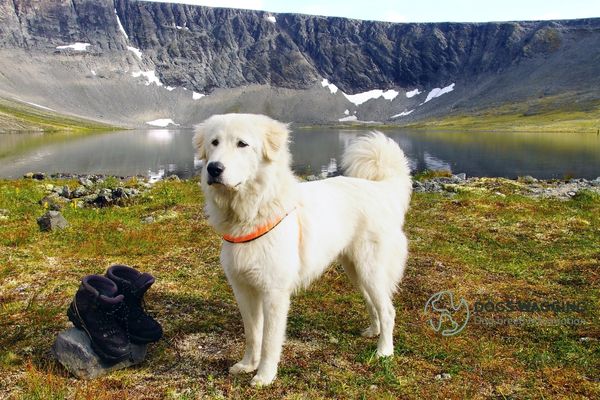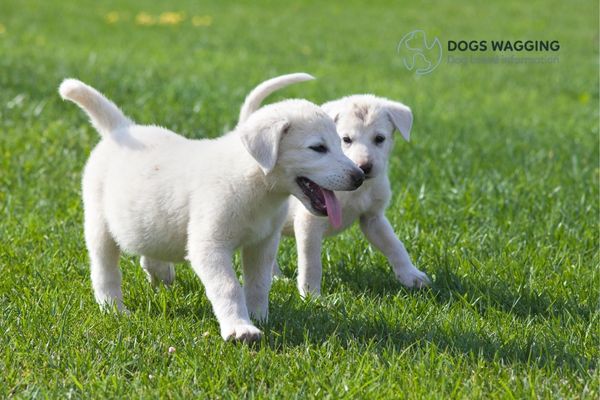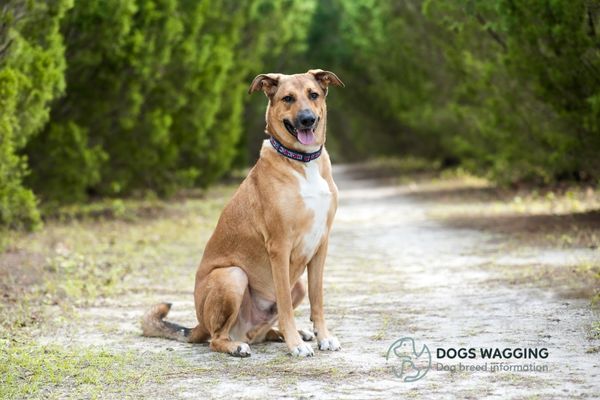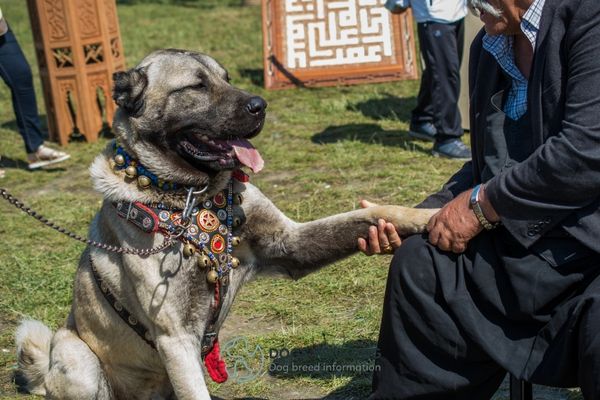John Switch • Fri Feb 23 2024
All Things About Anatolian Shepherd: Traits, Health Cares

Do you want to know more about Anatolian Shepherd Dogs? They originated in Turkey, where they were bred to be protectors of shepherds' livestock. They are a loyal, alert, stubborn dog breed with a large, muscular body. Therefore, you must properly train and socialize them to get a well-behaved Anatolian Shepherd.
This article will give you information about this dog breed, from its origin to appearance, personality, lifespan, health issues, caring, training tips, and so on.
Anatolian Shepherd Characteristics
The Anatolian Shepherd, sometimes called the Anatolian Karabash Dog, is known to be a large livestock guard dog breed. They were bred to protect sheep, goats, or cattle flocks, deterring predators from entering with their large bodies and loud barks.
They are dogs with highly protective and alert instincts, so they need to be socialized and trained when they are puppies. Anatolian Shepherds can be good family dogs if you have experience training with large, stubborn dogs.
Brief Traits
| Name: | Anatolian Shepherd, Anatolian Karabash |
| Height: | 27 to 29 inches |
| Weight: | 80 to 150 pounds |
| Lifespan: | 11 to 13 years |
| Colors: | Blue fawn, brindle, fawn, liver, red fawn, white, biscuit and white, or gray fawn |
| Temperament: | Loyal, Highly Protective, Stubborn, Alert |
Size
The Anatolian Shepherd is an impressively large dog breed that helps guard herds of cattle and sheep easily and intimidate unwanted invaders. In particular, the size between females and males is different. Males typically weigh 110-150 pounds and average 29 inches tall, and females weigh 80-120 pounds and 27 inches tall.
Coat Type & Color
This dog has a short coat with a thick undercoat. Sometimes, there is fur on the ears, legs, and tail. Their fur comes in many colors, including pinto, black, blue fawn, brindle, fawn, liver, red fawn, biscuit and white, or gray fawn with a variety of markings.
Temperament
Anatolian Shepherd Dog is highly intelligent, independent, and dominant. These are the necessary qualities that help it become the perfect livestock guardian. It tends to be protective of its family and herd and considers itself to be on a mission. This dog breed is very loyal and friendly to family members and people it is close to. However, this breed retains its working nature, is suspicious and wary of strangers, and reacts quickly to all surrounding threats.
Note: Your dog's personality will be influenced by many factors, including genetics, living environment, and training. For a dog to have a good temperament and be willing to approach people, you should train and socialize them when they are young.
Suitable Space for Living
Anatolian Shepherds are hardy dogs and can adapt to life outdoors, indoors, or both. But they are not suitable for living in kennels or at the end of the chain.
Instead, they will need spacious housing with a highly secure fenced garden. The fence must be at least 6 feet high to protect them, other animals, and strangers from accidentally entering their territory. If the garden borders other properties or public footpaths, you should use double fencing with delivery boxes located outside of the property.
The Origin of Anatolian Shepherd
The Anatolian Shepherd is an ancient breed that originated many centuries ago. This dog is named for their homeland of Anatolia in central Turkey. Due to the climate and topography of the area, local people have developed a nomadic lifestyle, dependent on herds of sheep and goats. These large dogs are responsible for protecting and herding those herds of sheep and goats. Therefore, they were called cobalt kopegi, which means "sheepdog" in Turkish.
They are agile enough to move quickly from one end of the flock to the other. They are also large enough to scare predators away from sheep and goats while being strong enough to survive an animal attack. That is why they are still used today to care for flocks worldwide day and night.
These dogs first came to the United States before World War II, but until 1996, the American Kennel Club recognized them.
Anatolian Shepherd Care Concerns
Anatolian Shepherds are naturally independent, highly protective, and wary of strangers. Therefore, proper training and socialization is necessary to ensure you get a well-adjusted Anatolian Shepherd. Although these dogs do not require much exercise, they still need a large space to roam. Luckily, their grooming needs are simple.
Feeding Needs
You can build the best diet for your Anatolian Shepherd Depending on the dog's preferences, size, and health conditions. It is good to feed them high-quality food, but you should discuss nutrition with your veterinarian or breeders. They have more in-depth knowledge and can make recommendations based on the dog's medical history.
Generally, a large-breed diet is suitable for these dogs. Moreover, you should feed your puppy food for large-breed puppies before switching to an adult diet.
What You Should Feed this Pet
Anatolian Shepherds can weigh anywhere from 80-150 pounds when fully grown, so their daily food requirements vary. To be sure, you should ask your veterinarian or breeders to build a good nutritional regimen for this furry friend. Additionally, you can follow the instructions on the dog food bag, showing you the appropriate serving size for your puppy based on its weight.
In particular, for Anatolian shepherd dogs with growth disorders and bone and joint problems such as hip or elbow dysplasia, providing nutritional supplements with glucosamine and chondroitin is essential. Supplementing them with omega-3 also helps protect and improve joint health.
How You Feed this Breed
Anatolian Shepherds are deep-chested dogs; through this characteristic, we know they are prone to GDV or bloat. To limit and prevent this dangerous situation, you should divide the food daily into 3 to 4 small meals for puppies. As it matures, you can reduce feeding times to twice a day.
Additionally, don't let them exercise around mealtimes, and don't feed your furry friend freely to avoid obesity.
Exercise Needs
Although this breed does not require much exercise, you should give them at least an hour of exercise every day to maintain good health. You can take it for walks, jogs, hikes, fetch games, etc. Puzzle toys are also a good choice to help them exercise and mental stimulation.
With a highly wary nature towards strangers and other animals, using a safe, private place with few strangers is ideal for them to exercise.
Grooming Needs
Good news for you if you plan to buy Anatolian Shepherd Dogs because they shed moderately all year round. Therefore, their coat requires low maintenance.
Coat
They have an undercoat that sheds twice a year, so at this stage, you need to brush them thoroughly every few days to remove dead hair. In addition, their short outer coat is smooth, you only need to brush it once a week for maintenance.
Eye
Anatolian Shepherd puppies may be born with entropion, a genetic eye disease, but they rarely have watery eyes or other eye problems. If you notice your dog has a lot of watery or red eyes, this is a sign of entropion, and you should see a veterinarian for an examination.
Ear
You should periodically clean their ears with an ear cleaner prescribed or recommended by the veterinarian. Doing this will help maintain a healthy ear canal and promptly detect ear diseases in your Anatolian Shepherd dogs if they show signs of infection. You should also clean his ears after your dog swims or bathes.
Training
Training an Anatolian Shepherd will be more difficult than other breeds, as they are independent working breeds. Consistent training from a young age with positive reinforcement is essential to creating a well-adjusted dog. You can register for a training class as soon as it is fully vaccinated.
Early socialization is important to help prevent your pup from thinking everything new is a threat. Although these dogs are stubborn, patience and maintenance of routine over a long period will make them very polite companions.
Anatolian Shepherd Health Issues
Anatolian Shepherds are a hardy breed. In fact, like all dog breeds, they are susceptible to certain health conditions. Having knowledge about some common diseases of this dog breed will help you detect diseases early and resolve them more quickly and effectively.
Here is some more information about health issues that can appear in this dog breed:
- Hip Dysplasia: This is a health condition in which the thigh bone does not fit properly with the hip joint. Some dogs exhibit pain and lameness in one or both hind legs
- Elbow Dysplasia: It is thought to be caused by growth disorder, leading to deformed and weakened joints. Some dogs may have simple arthritis, but some can't move normally.
- Anesthesia Sensitivity: When your dog needs anesthesia for surgery like spay/neuter surgery, teeth cleaning, etc. This problem will take them longer to recover from anesthesia.
- Entropion: It is caused when a dog's eyelids roll inward, resulting in the eyelashes rubbing against the cornea.
Pros and Cons - Anatolian Shepherd
| PROS | CONS |
| Loyal, protective | Independent, stubborn |
| Generally healthy | Wary of strangers |
| Low grooming needs | Require early socialization and training |
| Don't require a lot of exercise | Need a large space for living |
| Calm | Bark loudly |
FAQs: Anatolian Shepherd
Does this Dog Breed Bark a Lot?
Yes. Since Anatolian Shepherds originated as livestock guardians, they tend to bark. They bark a lot, especially when they realize strangers, intruders, or any threat to their livestock, relatives, or family, they will bark a lot.
Are Kangal Dogs and Anatolian Shepherd Dogs Similar?
Yes. Kangal dogs and Anatolian Shepherd dogs have many similar characteristics, so it wouldn't be surprising if you looked at them wrong. However, Kangal dogs are slightly larger and have longer fur. Both originate as livestock guardians, but Kangal dogs are more affectionate with their families, while Anatolian shepherds tend to enjoy more independence.
Are Anatolian Shepherds Aggressive?
Maybe. The protective instincts of Anatolian shepherds can become aggressive without proper training and socialization.
Conclusion
The Anatolian Shepherd is a large and strong livestock guardian dog that is known as loyal, protective, stubborn, and suspicious of strangers. Positive reinforcement and early socialization are essential training tips to get a well-behaved Anatolian Shepherd. If you want to buy or raise this dog breed, you need to think and research more about it before making a decision.

John Switch / Author
Hello this is a test author
Recent blog posts

John Switch • Fri Dec 29 2023
American Corgi: All Facts You Need to Know
An American Corgi are a mixed dog which is result of crossing two different breeds: the Cardigan and the Pembroke Welsh. Let's explore the allure of the Am

John Switch • Fri Dec 29 2023
Plott Hound Pitbull Mix: Everything You Need To Know
Are you in search of a unique and loyal companion? Look no further than the Plott Hound Pitbull mix. This nice hybrid breed combines the best traits of the

John Switch • Tue Jan 09 2024
Decoding The Charm Of Pit Bull Poodle Mix Breeds
Are you searching for a unique and charming canine friend? Look no further than the Pit Bull Poodle mix, also known as the Boodle. This fascinating mix comb

John Switch • Thu Jan 04 2024
Corgi Bulldog Mix: Dog Breed Information And Pictures
The Corgi Bulldog Mix, a charming hybrid breed, combines the distinctive features of the purebred Corgi and the English Bulldog. This dog breed is also know
 Anatolian Shepherd physical and temperament traits
Anatolian Shepherd physical and temperament traits The origin of Anatolian Shepherd
The origin of Anatolian Shepherd Anatolian Shepherd Puppies
Anatolian Shepherd Puppies Anatolian Shepherd Exercise Needs
Anatolian Shepherd Exercise Needs Anatolian Shepherd Training Tips
Anatolian Shepherd Training Tips